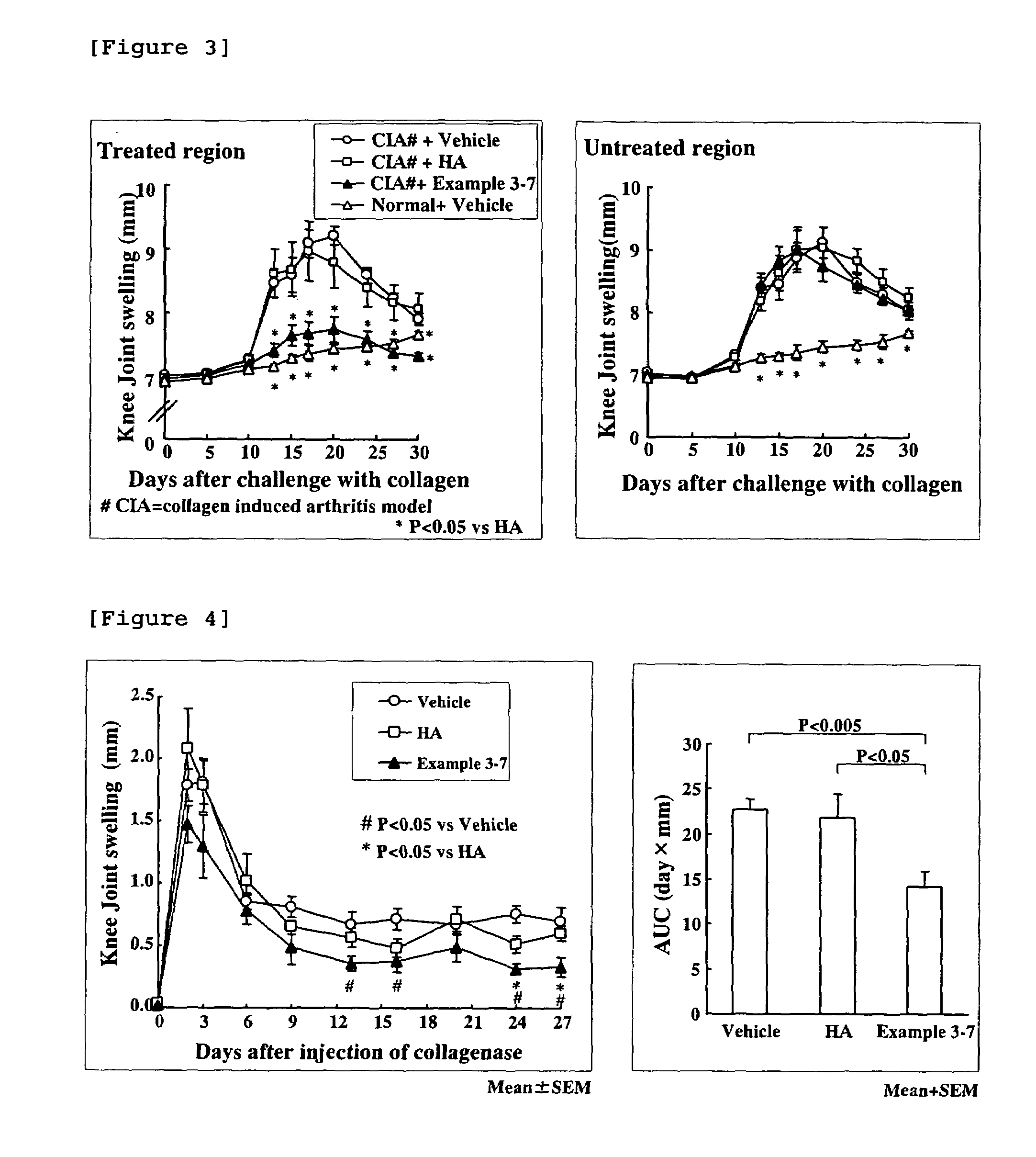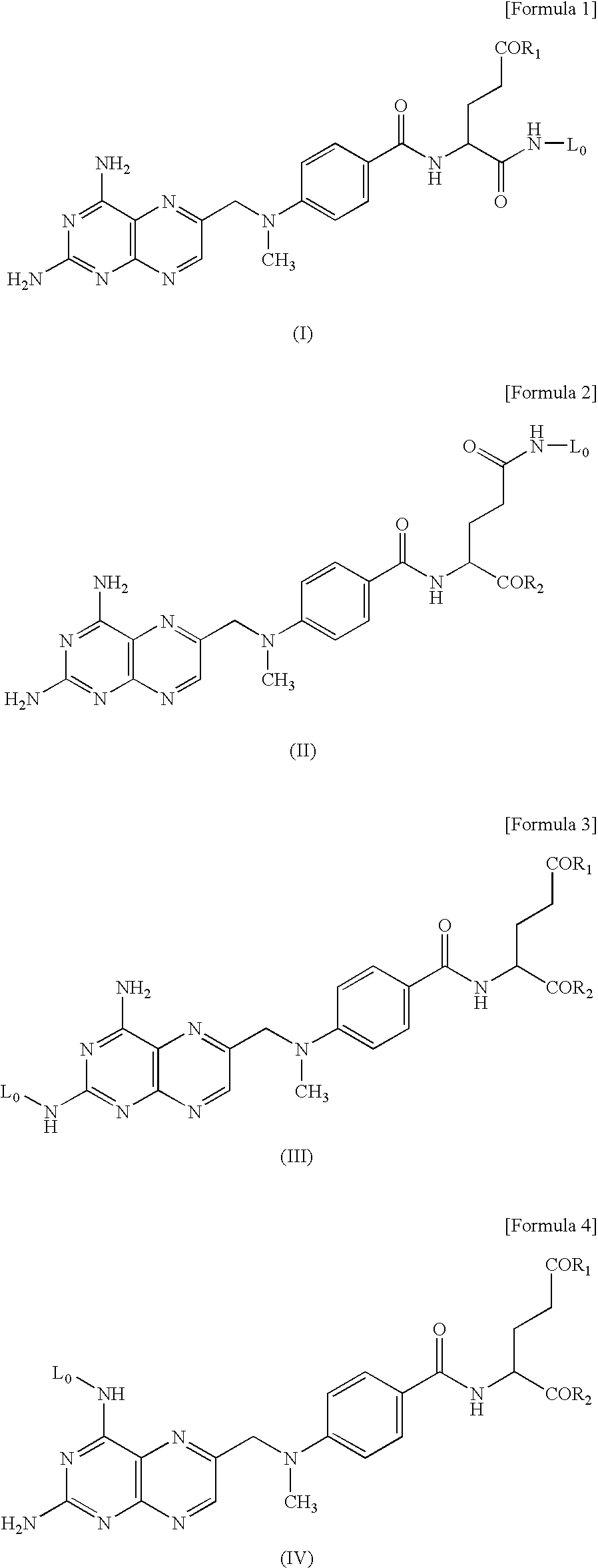Hyaluronic acid-methotrexate conjugate
a technology of hyaluronic acid and methotrexate, which is applied in the direction of metabolism disorders, drug compositions, peptides, etc., can solve the problems of insufficient diagnostic or therapeutic methods for mtx, gradual progression of pain, and safety problems of steroid preparations, so as to eliminate fears of systemic side effects and greatly reduce the dose of mtx
- Summary
- Abstract
- Description
- Claims
- Application Information
AI Technical Summary
Benefits of technology
Problems solved by technology
Method used
Image
Examples
example 1-1
Production of 2-[N—[N—[N-[4-[[(2,4-diamino-6-pteridinyl)methyl]methylamino]benzoyl]-α-(O5-methylglutamyl)]phenylalanyl]phenylalanylamino]ethylamine: MTX-α-PhePhe-NH—C2H4—NH2 (Compound 1)
(a) Production of Cbz-Phe-NH—C2H4—NH-Boc (Compound 1a)
[0115]N-carbobenzoxy-L-phenylalanine (Cbz-Phe: 7.16 g, 25.4 mmol), N-t-butoxycarbonyl-ethylenediamine hydrochloride (5.00 g, 25.4 mmol), 1-hydroxybenzotriazole hydrate (HOBT: 4.28 g, 28.0 mmol), and N-methylmorpholine (NMM: 3.07 mL, 28.0 mmol) were dissolved in 100 mL of dimethylformamide (DMF), to which 1-ethyl-3-(3-dimethylaminopropyl)carbodiimide hydrochloride (EDC: 5.36 g, 28.0 mmol) was then added under stirring and cooling with ice, followed by stirring at room temperature for one day. A 10% citric acid aqueous solution was added to the reaction solution, and the precipitated solid was dissolved in chloroform and a small amount of methanol, followed by washing the solution with a saturated sodium bicarbonate solution and a saturated saline s...
example 1-2
Production of 4,7,10-trioxa-13-[N—[N—[N-[4-[[(2,4-diamino-6-pteridinyl)methyl]methylamino]benzoyl]-α-(O5-methylglutamyl)]phenylalanyl]phenylalanylamino]tridecanylamine: MTX-α-PhePhe-NH—C10H20O3—NH2 (compound 2)
(a) Production of Cbz-Phe-NH—C10H20O3—NH-Boc (Compound 2a)
[0130]N-carbobenzoxy-L-phenylalanine (Cbz-Phe: 852 mg, 2.85 mmol), N-t-butoxycarbonyl-4,7,10-trioxa-1,13-tridecanediamine (760 mg, 2.37 mmol), and 1-hydroxybenzotriazole hydrate (HOBT: 363 mg, 2.37 mmol) were dissolved in 6 mL of dimethylformamide (DMF), to which 1-ethyl-3-(3-dimethylaminopropyl)carbodiimide hydrochloride (EDC: 546 mg, 2.85 mmol) was then added under stirring and cooling with ice, followed by stirring at room temperature for two days. Ethyl acetate was added to the reaction solution, followed by washing with a 10% citric acid aqueous solution, a 5% sodium bicarbonate solution, and a saturated saline solution before drying with sodium sulfate. It was concentrated under reduced pressure, followed by purif...
example 1-2 ′
Example 1-2′
Production of 4,7,10-trioxa-13-[N—[N—[N-[4-[[(2,4-diamino-6-pteridinyl)methyl]methylamino]benzoyl]-α-(O5-ethylglutamyl)]phenylalanyl]phenylalanylamino]tridecanylamine: MTX(Et)-α-PhePhe-NH—C10H20O3—NH2 (Compound 2′)
[0145]In a method similar to that in Example 1-2, N-carbobenzoxy-L-glutamic acid-γ-ethyl ester (Cbz-Glu(OEt)) was used in place of N-carbobenzoxy-L-glutamic acid-γ-methyl ester (Cbz-Glu(OMe)) to provide 1.02 g of the title compound as a yellow powder.
[0146]1H-NMR (270 MHz, DMSO-d6): δ1.13 (3H, t, J=7.0 Hz), 1.49-1.61 (4H, m), 1.80-1.96 (2H, m), 2.19-2.28 (2H, m), 2.53-2.58 (2H, m), 2.72-3.12 (6H, m), 3.22 (3H, s), 3.27-3.47 (12H, m), 4.00 (2H, q, J=7.1 Hz), 4.28-4.50 (3H, m), 4.79 (2H, s), 6.62 (2H, br.s), 6.81 (2H, d, J=8.6 Hz), 7.08-7.21 (10H, m), 7.46 (1H, br.s), 7.65-7.88 (5H, m), 8.08-8.18 (2H, m), 8.55 (1H, s).
[0147]LC / MS: 979.5 (M+H+)
PUM
| Property | Measurement | Unit |
|---|---|---|
| molecular weight | aaaaa | aaaaa |
| molecular weight | aaaaa | aaaaa |
| average molecular weight | aaaaa | aaaaa |
Abstract
Description
Claims
Application Information
 Login to View More
Login to View More - R&D
- Intellectual Property
- Life Sciences
- Materials
- Tech Scout
- Unparalleled Data Quality
- Higher Quality Content
- 60% Fewer Hallucinations
Browse by: Latest US Patents, China's latest patents, Technical Efficacy Thesaurus, Application Domain, Technology Topic, Popular Technical Reports.
© 2025 PatSnap. All rights reserved.Legal|Privacy policy|Modern Slavery Act Transparency Statement|Sitemap|About US| Contact US: help@patsnap.com



